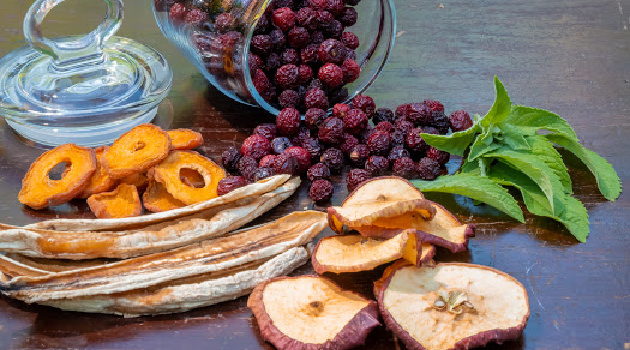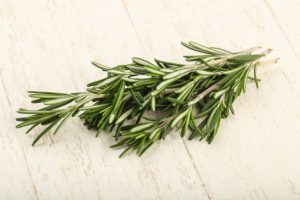Rosemary is an attractive woody perennial herb belonging to the mint family, Lamiaceae, and is believed to have originated from the Mediterranean region.
The herb is popularly known for its attractive evergreen needle-like leaves and the brilliant blue flowers—which often stay around through spring and summer.
It thrives best in sunny locations with moderate humidity. In zones 7 or warmer, plant outdoors as a perennial shrub. However, in colder areas, keep in a pot and bring indoors in the winter.
Though popular in dish seasoning, rosemary also makes great ornamental plantings in a landscape, which is in addition to the medicinal value it carries.

Rosemary in Traditional Medicine
Other than cooking, the ancient people also used this herb for memory and immunity-boosting, to alleviate muscle pain, promote hair growth, and also as a booster to the circulation system.
Rosemary plants
There are numerous varieties of rosemary plants, but we can simply categorize them into two; Upright and creeping. Both are highly fragrant.
Creepers make excellent ground covers, spill over walls, and also add stability to slopes. The upright varieties are better suited for topiary, hedges, and specimen plants.
For boarders, rockeries, and container growing, choose the dwarf variety. It’s a lot easier to train and trim into topiary or as a bonsai.
Chef’s Choice is a perfect option for a kitchen garden. This mounded variety matures to a height of 12-18 inches and is hardy in zones 7 through 10.
If draping beauty to your container garden is all you want, then go for prostrates. It will as well creep over your low walls adding the ‘unbudgeted for’ aesthetic value to your structure.
Arp variety is the best if you want something cold-hardy. It’s usually dense and grows up to 5 feet tall. It grows in USDA zones 6-10.
Rosemary Growing and Care Instructions
Rosemary is an easy-to-grow and care-for herb, just like most of the mint-family herbs lavender, oregano, and thyme.
You can grow it indoors or outdoors; in containers and the ground, depending on your climate.
In cold climates, grow the herb in a pot so you can quickly bring it indoors, especially during the winter season. More often than not, rosemary plants succumb to the cold of winter. However, some varieties are more cold-hardy than others, and Arp is one such good example.
In warm climates, the herb grows into tall shrubs with a height of up to 6-7 feet for the Upright variety AND 2-3 feet for the smaller types.
Rosemary prefers somewhat dry soil. Therefore, consider terra cotta pots if you intend to do container gardening. These pots allow water and air to move through the pot walls, thus preventing root rot and any possible soil diseases.
Growing needs
1. Light
Grow it in full sun. For indoor growing, place in a South-facing window to allow for at least 6 hours of sunlight a day.
2. Soil
Rosemary thrives best in well-drained and slightly acidic soil with a pH value of between 6.0 and 7.0. Sandy soil is preferable; however, most varieties will still do well in loamy soils.
And so, to begin with, choose your preferred site and prepare the soil.
Soil preparation
Clear off the planting site by removing all weeds, tree roots, shrubs, rocks, and any other plant debris.
Have the soil analyzed for nutrient and pH level. Simply collect a sample and take it to your local soil testing laboratory. Fertilize as required based on the soil test results. You can always increase the soil’s alkalinity level by adding lime if it turns out to be too low.
Slightly raise the planting site to enhance drainage.
Add compost or organic matter (about 4 inches) to the soil’s surface and work it 6-8 inches deep into the ground. You can use a rototiller or pitchfork.
3. Planting
Rosemary can be started from seeds; however, the germination rate is usually quite low—about 15%. Therefore, consider growing from cuttings or transplants.
- Get an already vigorous rosemary plant and clip a branch with new growth from its stem—about 3 inches.
- Use a sharp scissor to cut back the stem. Cut extra stems to replace those that fail to grow roots.
- Remove the lower leaves and leave about 1.5 inches up the stem.
- Get a 3-inch pot and plant therein the cutting(s). After that, water thoroughly.
- The cuttings tend to shoot faster under temperatures of between 60 and 70 degrees, and so a spot with indirect sunlight on your windowsill would be the best.
- Transplant to the ground after about 8 weeks when the cuttings will have rooted.
Care Tips
1. Watering
Consider deep soaking the soil immediately after planting—including the root ball area—to a height or level equal to that of the root ball. However, be careful not to overwater.
Be sure to often check and adjust your irrigation time whenever necessary during the initial weeks after planting—to help keep the soil moist and not wet.
Once established, rosemary enjoys staying dry. It’s mainly during the prolonged summer drought periods that it will require supplemental watering. A good sign that your rosemary plant is in dire need of water during a dry season—is when the leaves become pale or begin to fall off from the stem.
The rule of thumb though, is to only water when the soil feels dry.
2. Fertilizing Rosemary
Rosemary, rarely, requires fertilizer. But you can apply fertilizer in late winter or early spring before new growth appears, especially if you notice stunted or slow growth in the plant. Also, yellowing may be a sign that your rosemary requires feeding.
Hint: Stop fertilization two months before your first frost date to avoid encouraging new growth that could easily be destroyed by an early frost.
3. Pruning
You don’t want the plant to get lanky, so prune regularly. This should be immediately after blooming in late spring.
Note that the more you prune your rosemary, the more bushy and compact it will become. Depending on your desired shape (whether a tree, corn, or globe shape), begin the pruning when the plant is still young.
Do not trim past the older woody stems during the plant’s active growth season.
You can as well hard-prune your rosemary in winter (when there isn’t active growth) as this helps the plant grow back fully and better than ever in spring. Cut back the plant to about half its height while making sure that you don’t cut beyond an area on a given stem with no leaves.
Harvesting Rosemary
Harvest rosemary in the summer or spring when it’s actively growing to enhance the growth of new sprigs.
You can snip off some of the stems every day or once weekly, and use when fresh or simply hang them upside down in the kitchen to dry.
For the best flavor, harvest stems in the morning—when the dew is gone, just before the day’s heat sets in.
Select the tender tips, cutting the stems 6-8 inches long.
Drying Rosemary

Like most herbs, rosemary stores best when dry, although even freezing works just as well.
Before drying, remove any hard or woody stems and then rinse with clean water. This is to remove dirt or pests that may have clung to the herb.
Use a paper towel or salad spinner to dry any excess water then proceed to use any of the drying methods below.
1. Oven drying
You’ll need an oven (or a gas stove) and some baking sheets.
For an oven—pre-heat to the lowest temperature; AND set to warm in the case of a gas stove.
Put the fresh stems and leaves on the baking sheet, spreading to ensure no overcrowding. You can as well place the herb directly onto the baking tray. However, be sure to set the temperature as low as possible.
Baking takes 2-4 hours, but keep on checking from time to time till they become brittle.
All this time, the oven door should remain open at about 2 inches to allow adequate air circulation, which in turn helps prevent the oven from overheating.
2. Air-drying
Divide your sprigs into individual groups. Then tie each bunch at the base with rubber bands, kitchen twine, or a string.
Cover with a well-perforated paper bag and hang to dry in a well-ventilated area of your house. This can be the attic, cupboard, or porch.
The paper bag here helps protect the plant from insects, sunlight, and dust.
Your rosemary stems and leaves should be dry after two weeks.
Hint: When completely dry, the herb’s parts (as a whole or semi-whole) should crumble when touched and no longer bend.
3. Drying by dehydration
Place your rosemary fresh stems and leaves on a baking sheet, and spread well to avoid overcrowding.
Switch on the dehydrator and set the temperature at 95 degrees Fahrenheit. Then put the herb on the tray and leave to dry for 4-6 hours. Regularly check until they become brittle.
Freezing rosemary
Fill your ice cube trays (halfway) with water, put in the leaves, and freeze.
Once frozen, transfer the rosemary cubes to a plastic bag and remove them to use when needed.
Storing rosemary
Once dry, rosemary can store up to a year or more. Use a tightly sealed container and store it in a cool, dark, dry place.
This should not be anywhere near your oven or any other source of heat. And so the cabinets in the coldest part of your kitchen (or in a fruit or cold-storage cellar) are the best.
Cooking with Rosemary
Rosemary has long been used in stews, in the seasoning of lamb, fish as well as poultry.
Its delicious pinewood flavor is also a great additive to bread and compound butter and is liberally used in the dressing, stuffing, jam, vinaigrettes, and vegetable dishes.
You can use dried or frozen rosemary for cooking; however, the flavor tends to be best when the herb is used fresh.
Use rosemary in moderation to avoid over-flavoring your dish.
Also, don’t cook it for too long, especially if using in dried form. Drying concentrates rosemary flavor, and so excessive long hours of cooking can make the dish bitter. This is because dried rosemary continues to release its volatile oils responsible for the taste over quite an extended period.

The Takeaway: Rosemary is Easy to Grow. Still, Watch for These Problems
In as much as rosemary is an easy-to-grow and care-for herb, there are quite some problems you should look out for.
These include the following:
Root rot
It’s the most common and can quickly lead to the plant’s death. Rosemary roots can’t withstand wet or soggy conditions, therefore, ensure the soil drains well. You can add in grit or coarse sand to boost the soil drainage.
Pests
Spittlebugs and aphids are the primary culprits here. Just a strong gust of water from your garden hose is enough to quickly wash them away.
Powdery mildew
This is more common in indoor potted plants where overcrowding and damp conditions are almost the norm.
Consider removing all the infected stems and try as much as possible not to overwater the plant(s).
Provide enough spacing with proper air circulation to keep your rosemary flourishing.
Content last updated 07.10.2021

